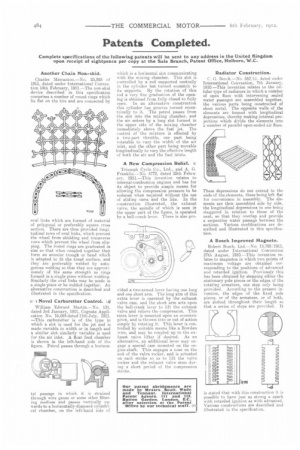Patents Completed.
Page 22

If you've noticed an error in this article please click here to report it so we can fix it.
Complete specifications of the following patents will be sent to any address in the United Kingdom upon receipt of eightpence per copy at the Sale Branch, Patent Office, Holborn, W.C.
Another Chain Non-skid.
Charles Mereanton.—No. 23,593 of 1911, dated under International Convention 14th February, 1911.—The non-skid device described in this specification comprises a number of round rings which lie flat on the tire and are connected by oval links which are formed of material of polygonal or preferably square cross section. There are thus provided longitudinal rows of oval links, which prevent the wheel from skidding and transverse rows which prevent the wheel from slipping. The round rings are graduated in size so that when coupled together they form an annular trough or band which is adapted to fit the tread surface, and they are preferably welded by auto. genous welding so that they are approximately of the same strength as rings formed in a single piece without welding. Similarly the oral linksmay be made in a single piece or be welded together. An alternative construction is described and illustrated in the specification.
i Novel Carburetter Control.
William Edward Martin.—No. 131. dated 3rd January, 1911, Cognate Application No. 16,084 dated Ilth July, 1911. —This carburetter is of the type in which a slot is used for the jet and is made variable in width or in length and a similar slot similarly variable is used for the air inlet. A float feed chamber is shown in the left-hand side of the figure. Petrol passes through a horizon tal passage in which it is strained through wire gauze or some other filtering medium and passes vertically upwards to a horizontally-disposed cylindrical chamber, on the left-hand side of which is a horizontal slot communicating with the mixing chamber. This slot is controlled by a rod supported centrally in the cylinder but turned eccentric to its supports. By the rotation of this rod a very fine graduation of the opening is obtained from fully closed to fully open. In an alternative construction this cylinder has grooves turned eccentrically to it. The petrol passes from the slot into the mixing chamber, and the air enters by a long slot formed in the upper side of the mixing chamber immediately above the fuel jet. The control of the mixture is effected by a two-part throttle, one part being rotatable to vary the width of the air inlet, and the other part being movable longitudinally to vary the effective length of both the air and the fuel inlets.
A New Compression Relief.
Triumph Cycle Co., Ltd., and A. G. Franklin.—No. 4772, dated 25th February, 1911.—This invention relates to internal-combustion engines and has for its object to provide simple means for allowing the compression pressure to be reduced when required without the use of sliding cams and the like. In the construction illustrated, the exhaust valve, the spindle of which is seen in the upper part of the figure, is operated by a bell-crank lever. There is also pro sided a two-armed lever having one long and one short arm. The long arm of this extra lever is operated by the exhaust valve cam, and the short arm acts upon the bell-crank lever to lift the exhaust valve and relieve the compression. This extra lever is mounted upon an eccentric pivot, and is thrown into or out of action simply by rotating it. This lever is controlled by suitable means like a Bowden wire, and may be coupled up to the exhaust valve lifter if desired. As an alternative, an additional lever may engage a special cam mounted on the engine-shaft. This engages a nose on the end of the valve rocker, and is actuated on each stroke so as to lift the valve rocker and the exhaust valve stem during a short period of the compression stroke.
Radiator Construction.
C. G. Boeck.—No. 562i11. dated under International Convention, 7th January. 1910.—This invention relates to the cellular type of radiators in which a number of open flues with intervening sealed water passages are assembled together, the various parts being constructed of sheet metal. The opposite walls of the elements are formed with longitudinal depressions, thereby making internal projections which divide the elements into a number of parallel open-ended air flues.
These depressions do not extend to the ends of the elements, these being left flat for convenience in assembly. The elements are then assembled side by side, the longitudinal depressions in one being staggered in relation to those of the next, so that they overlap and provide a serpentine water passage between the sections. Various modifications are described and illustrated in this specification.
A Bosch Improved Magneto.
Robert Bosch, Ltd.—No. 13,70511911, dated under International Convention 27th August, 1910.—This invention relatea to magnetos in which two points of maximum voltage are obtained corresponding to the positions of advanced and retarded ignition. Previously this has been obtained by stepping either the stationary pole pieces or the edges of the rotating armature, one step only being provided. According to the present invention, the edges of the fixed pole pieces. or of the armature, or of both, are slotted throughout their length so that a series of steps are provided. It is stated that with this construction it is possible to have just as strong a spark with retarded ignition as with advanced. Various constructions are described and illustrated in the specification.






















